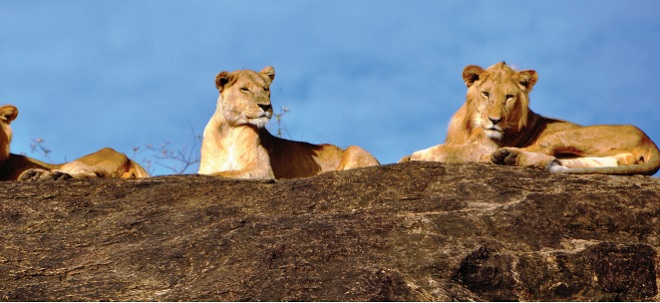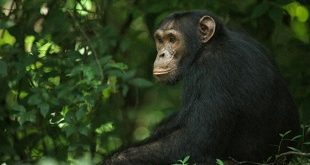
The big cats are horribly easy to kill with poisoned meat, allowing poachers to hack off their faces and paws
Kampala, Uganda | DAMIAN CARRINGTON | That’s fresh, just a few hours old,” says Kris Everatt, pointing at a clear print of a lion’s paw in the hot dust. “It’s the ghost pride.” The print is female. A bigger male print is soon spotted, also leading towards a precious water hole, then a smaller one. “A cub, less than two years old,” he says.
The anti-poaching patrol continues its careful tracking across the parched landscape of Limpopo national park (LNP) in Mozambique. Hippos wallow nearby, crocodiles sun themselves and baboons yell alarms calls at the rangers – but the team don’t find the lions.
Everatt, from the global wild cat conservation group Panthera, is pleased nonetheless. “I’m so happy – at least there are still lions here.” The ghost pride, who live along the Machampane river, have very good reason for being elusive they have been deliberately poisoned three times since 2015. Nine lions died, their faces and paws hacked off by the poachers, and the Limpopo park’s lion population is in freefall.
The targeted poaching attacks are a new and horrific danger to lions, which were already under serious threat across Africa from destruction of habitat and the snaring of their prey for bushmeat. There are now fewer lions left than elephants.
“Poaching has the potential to be incredibly detrimental to Africa’s wild lions,” says Everatt. “This is something we definitely didn’t need another huge challenge.” “It happened really fast in Mozambique, and it could happen really fast in the rest of Africa,” he says. Lion poaching has already been reported from Zimbabwe, South Africa, Tanzania, and Uganda.
“You could end up with the only place left with wild lions in Africa being Kruger national park,” a wellprotected refuge across the border in South Africa, he says.
The poaching problem is especially worrying because it is far easier to poach lions than elephants or rhino. Lions scavenge, so poachers only need to snare an antelope, poison the carcass with pesticide and wait. “I feel like I am racing the poachers to find the lions, and they have the advantage because they don’t actually have to see the lions,” says Everatt.
“Lions are much easier to kill than to study.” On the way back from the patrol, Everatt stops his Land Cruiser to watch African white-backed vultures circling a couple of hundred metres away they could signal a predator kill and, perhaps, lions. Striding off, he kicks a rusted blue enamel bowl discarded in the dirt. “Poachers,” he spits.
There are 20 or more vultures roosting in a tall dead tree, suggesting a big animal has been killed nearby. He walks downwind: “I use smell all the time, so much so that the smell of a rotten animal is actually good to me now. I have found a lot of poaching incidents this way.” But, again, no lions are found. Even technology doesn’t guarantee a successful search.
The day before, Everatt searched for a big male, Culu, who roams between Mozambique and Kruger national park, coming close to some infamous poaching villages. Everatt has collared Culu, but standing on top of his vehicle with an antenna listening for a radio beep, he found the lion elusive this time. “I think Culu is going to be poached,” he says. “It is kind of inevitable.
There are a lot more poachers than rangers.” LNP is roughly seven times the size of Greater London in the UK but has just 100 rangers in the field. Time is against the Limpopo lions. Their numbers have crashed from 66 to 21 in only five years, according to survey data soon to be published by Everatt.
Based on the prey available, the area should support up to 200 lions. “Targeted poaching has emerged over the last few years to be the number one threat to the viability of these lions,” he says. “The decline is so steep that you would not expect lions to be around in the park in a couple of years’ time.” The change from 2014 is so stark that Everatt thinks that must be when criminals first showed up wanting to buy lion parts.
Who is driving the demand for lion teeth and claws is unclear: illegal trade is by its nature shady. But they have turned up alongside elephant ivory and rhino horn in shipments destined for east Asia. There is also a local market in southern Africa for use in traditional magic.
A few poached lions have also had their bones removed, potentially linking them to the controversial legal trade in farmed lion bones in South Africa. With just a few thousand tigers left, lion bones are now being used as replacement in Asian tiger cake and wine.
Camera traps set for wildlife in LNP have snapped poachers returning from Kruger with tusks and rhino horn. But rhinos, already wiped out in LNP, are becoming rarer, so it appears lions are now being targeted as another way to make money, says Everatt: “A lot of the time it is the same people, and often on the same trip.” The most recent poaching attack in LNP hit the ghost pride in January: four lions died, along with dozens of vultures.
One of Everatt’s team broke down in tears at the sight of the mutilated carcasses. “It’s gruesome and I do have an emotional reaction, but I try not to,” he says. “You couldn’t deal with it if you did. It just keeps happening.” But such sights spurred Everatt to set up his six-strong Lion Unit in LNP. “If I had not, I think there would probably be none left.”
 The Independent Uganda: You get the Truth we Pay the Price
The Independent Uganda: You get the Truth we Pay the Price


